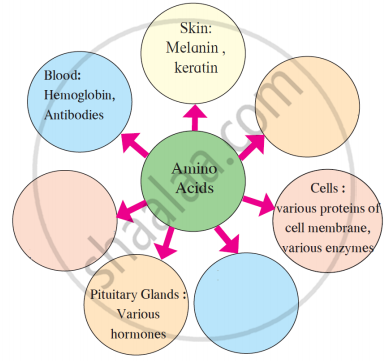Advertisements
Advertisements
Question
Answer the following question.
Write explanatory notes on Electron transport chain.
Solution
- NADH2 and FADH2 produced during glycolysis, connecting link reaction and Krebs cycle are oxidized with the help of various electron carriers and enzymes.
- These carriers and enzymes are arranged on the inner mitochondrial membrane in the form of various complexes as complex I, II, III, VI, and V.
- NADH+H+ is oxidized by NADH dehydrogenase (complex I) and it's electrons are transferred to ubiquinone (coenzyme Q-CoQ) present on the inner membrane of mitochondria. Reduced ubiquinone is called as ubiquinol.
- FADH2 is oxidized by complex II (Succinate dehydrogenase) and these electrons are also transferred to CoQ.
- During oxidation of NADH+H+ and FADH2, electrons and protons are released but only electrons are carried forward whereas protons are released into the outer chamber of mitochondria (intermembrane space).
- Ubiquinol is oxidized by complex-III (Cytochrome bc1 complex) and it's electrons are transferred to cytochrome C. Cytochrome C is a small, iron-containing protein, loosely associated with the inner membrane. It acts as a mobile electron carrier, transferring the electrons between complex III and IV.
- Cytochrome C is oxidized by complex IV or cytochrome C oxidase consisting of cytochrome a and a3. Electrons are transferred by this complex to the molecular oxygen. This is terminal oxidation.
- Reduced molecular oxygen reacts with protons to form a water molecule called as metabolic water.
- Protons necessary for this are channelled from the outer chamber of mitochondria into inner chamber by F0 part of oxysome (complex V) present in the inner mitochondrial membrane. This proton channelling by F0 is coupled to the catalytic site of F1 which catalyzes the synthesis of ATP from ADP and inorganic phosphate. This is oxidative phosphorylation. As the transfer of protons is accompanied by a synthesis of ATP, this process is named 'Chemiosmosis' by Peter Mitchell.
Significance of ETS:
- Major amount of energy is generated through ETS or terminal oxidation in the form of ATP molecules.
- Per glucose molecule 38 ATP molecules are formed, out of which 34 ATP molecules are produced through ETS.
- Oxidized coenzymes such as NAD and FAD are regenerated from their reduced forms (NADH+H+ and FADH2) for recycling.
- In this process, energy is released in a controlled and stepwise manner to prevent any damage to the cell.
- ETS produces water molecules.
APPEARS IN
RELATED QUESTIONS
Redraw the flow-chart with corrections. Explain in brief the process of obtaining energy through oxidation of carbohydrates, lipids & proteins.

Write definition.
Aerobic respiration
We get __________ energy from lipids.
What are the main steps of anaerobic respiration?
Complete the following concept map.

Identify the statement that correctly describes phosphorylation.
Read the following statements and select the CORRECT option.
Statement I: In oxidative phosphorylation ATP is synthesized by using the energy released during the oxidation of substrates like NADH+ H+ and FADH2.
Statement II: Substrate-level phosphorylation is a direct phosphorylation of ADP by transfer of a phosphate group from any suitable substrate.
Oxidative phosphorylation refers to ______
Identify the cell organelle that is responsible for extracting energy from carbohydrates to form ATP.
In the mitochondrion, energy is stored in the form of ____________.
